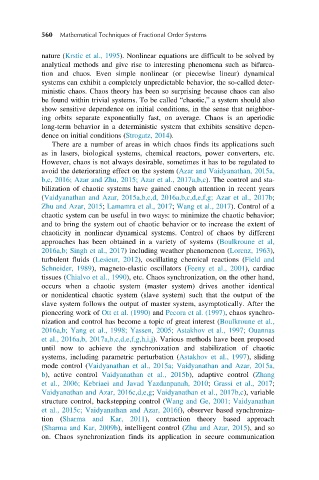Page 590 - Mathematical Techniques of Fractional Order Systems
P. 590
560 Mathematical Techniques of Fractional Order Systems
nature (Krstic et al., 1995). Nonlinear equations are difficult to be solved by
analytical methods and give rise to interesting phenomena such as bifurca-
tion and chaos. Even simple nonlinear (or piecewise linear) dynamical
systems can exhibit a completely unpredictable behavior, the so-called deter-
ministic chaos. Chaos theory has been so surprising because chaos can also
be found within trivial systems. To be called “chaotic,” a system should also
show sensitive dependence on initial conditions, in the sense that neighbor-
ing orbits separate exponentially fast, on average. Chaos is an aperiodic
long-term behavior in a deterministic system that exhibits sensitive depen-
dence on initial conditions (Strogatz, 2014).
There are a number of areas in which chaos finds its applications such
as in lasers, biological systems, chemical reactors, power converters, etc.
However, chaos is not always desirable, sometimes it has to be regulated to
avoid the deteriorating effect on the system (Azar and Vaidyanathan, 2015a,
b,c, 2016; Azar and Zhu, 2015; Azar et al., 2017a,b,c). The control and sta-
bilization of chaotic systems have gained enough attention in recent years
(Vaidyanathan and Azar, 2015a,b,c,d, 2016a,b,c,d,e,f,g; Azar et al., 2017b;
Zhu and Azar, 2015; Lamamra et al., 2017; Wang et al., 2017). Control of a
chaotic system can be useful in two ways: to minimize the chaotic behavior;
and to bring the system out of chaotic behavior or to increase the extent of
chaoticity in nonlinear dynamical systems. Control of chaos by different
approaches has been obtained in a variety of systems (Boulkroune et al,
2016a,b; Singh et al., 2017) including weather phenomenon (Lorenz, 1963),
turbulent fluids (Lesieur, 2012), oscillating chemical reactions (Field and
Schneider, 1989), magneto-elastic oscillators (Feeny et al., 2001), cardiac
tissues (Chialvo et al., 1990), etc. Chaos synchronization, on the other hand,
occurs when a chaotic system (master system) drives another identical
or nonidentical chaotic system (slave system) such that the output of the
slave system follows the output of master system, asymptotically. After the
pioneering work of Ott et al. (1990) and Pecora et al. (1997), chaos synchro-
nization and control has become a topic of great interest (Boulkroune et al.,
2016a,b; Yang et al., 1998; Yassen, 2005; Astakhov et al., 1997; Ouannas
et al., 2016a,b, 2017a,b,c,d,e,f,g,h,i,j). Various methods have been proposed
until now to achieve the synchronization and stabilization of chaotic
systems, including parametric perturbation (Astakhov et al., 1997), sliding
mode control (Vaidyanathan et al., 2015a; Vaidyanathan and Azar, 2015a,
b), active control Vaidyanathan et al., 2015b), adaptive control (Zhang
et al., 2006; Kebriaei and Javad Yazdanpanah, 2010; Grassi et al., 2017;
Vaidyanathan and Azar, 2016c,d,e,g; Vaidyanathan et al., 2017b,c), variable
structure control, backstepping control (Wang and Ge, 2001; Vaidyanathan
et al., 2015c; Vaidyanathan and Azar, 2016f), observer based synchroniza-
tion (Sharma and Kar, 2011), contraction theory based approach
(Sharma and Kar, 2009b), intelligent control (Zhu and Azar, 2015), and so
on. Chaos synchronization finds its application in secure communication

